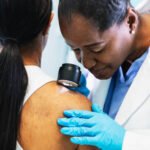Mental health is just as important as physical health, especially during the transition from adolescence to adulthood. For some young adults, sudden mood changes, unusual energy spikes, or deep depression may be early signs of bipolar disorder — a serious but manageable mental illness. But because symptoms can mimic typical “growing pains” or stress, many early cases go undetected. 😞
Knowing what to look for — and what not to ignore — could make all the difference. Early recognition and intervention lead to better outcomes, stronger coping strategies, and a more fulfilling life. Let’s explore the early signs, causes, and what to do if you or someone you love might be at risk. 🧑🎓💬
👩⚕️ What Is Bipolar Disorder?
Bipolar disorder is a chronic mental health condition that causes dramatic shifts in mood, energy, focus, and behavior. It’s categorized by:
- Manic episodes: periods of extreme euphoria, energy, and sometimes risky behaviors
- Depressive episodes: deep sadness, hopelessness, and lack of motivation
Some people may also experience “mixed episodes”, where symptoms of mania and depression happen at the same time.
- Bipolar I: At least one manic episode, often with depressive episodes
- Bipolar II: At least one hypomanic episode (less severe mania) and one major depressive episode
- Cyclothymic Disorder: Ongoing mood fluctuations for 2+ years, but not full manic or depressive episodes
Most people develop symptoms between late teens and mid-20s, which is why it’s crucial to identify bipolar disorder early in young adults. 📘
🚨 Early Warning Signs of Bipolar Disorder in Young Adults
Recognizing bipolar disorder early isn’t always easy. The symptoms often come and go, and they can be misunderstood as stress, anxiety, or even personality changes. But certain patterns stand out when you know what to watch for.
⚡ Mania or Hypomania (High Energy Episodes):
- Reduced need for sleep (sleeping 2–3 hours and feeling fine)
- Increased talkativeness or pressured speech
- Racing thoughts or distractibility
- Overconfidence or inflated self-esteem (“I’m invincible”)
- Impulsive decisions (quitting school, reckless spending, unsafe sex)
- Overactivity or restlessness (starting multiple tasks but finishing none)
- Unusual creativity bursts or grand ideas
💬 Example: A college student suddenly decides to start three businesses, barely sleeps, and feels unstoppable — but within days, crashes into exhaustion and depression.
🌧️ Depressive Episodes:
- Persistent sadness, hopelessness, or emptiness
- Loss of interest in activities once enjoyed
- Sleeping too much or too little
- Appetite changes (weight gain or loss)
- Feelings of guilt or worthlessness
- Fatigue or low energy
- Thoughts of death or suicide
💬 Example: A once-social student begins skipping classes, isolates from friends, and talks about feeling like a failure.
🧬 What Causes Bipolar Disorder?
Bipolar disorder doesn’t have one clear cause — it’s influenced by a combination of biological, genetic, and environmental factors.
🧠 Key Contributors:
- Genetics: A family history of bipolar disorder or depression increases risk
- Brain structure and function: Abnormalities in brain circuits and neurotransmitters like dopamine, serotonin, and norepinephrine
- Stress or trauma: Abuse, loss, or ongoing stress can trigger episodes
- Substance abuse: Drugs and alcohol may trigger manic or depressive episodes
It’s important to remember: bipolar disorder is not anyone’s fault. It’s a treatable medical condition — not a weakness, flaw, or phase. 🧬💙
🔍 Why Early Detection Matters
Bipolar disorder can escalate over time. Without diagnosis and support, young adults may face:
- Academic failure or school dropout 🎓
- Relationship breakdowns 💔
- Substance use disorders 🧪
- Financial troubles 💸
- Increased suicide risk 🚨
However, early intervention leads to:
✅ More stable mood regulation
✅ Fewer relapses and hospitalizations
✅ Better medication and therapy response
✅ Improved quality of life and independence
✅ Empowerment to manage their mental health proactively
🧭 What to Do if You See the Signs
If you or a loved one is showing signs of bipolar disorder:
✅ Steps to Take:
- Keep a mood diary: Track sleep, mood, energy, and behavior patterns
- Talk to a mental health professional: A psychiatrist can provide diagnosis and treatment
- Avoid self-diagnosing: Online quizzes aren’t enough — seek expert evaluation
- Involve supportive people: Friends, family, and school counselors can offer guidance
- Don’t delay: The longer bipolar disorder goes untreated, the more disruptive it can become
📞 Emergency? Call a mental health crisis line or go to the nearest hospital if there’s any risk of self-harm or suicide.
🫂 Treatment and Support Options
Treatment for bipolar disorder is lifelong — but very effective when tailored to the individual.
🌿 Common Treatment Options:
- Mood stabilizers (like lithium)
- Antipsychotics for severe mania
- Antidepressants, cautiously used alongside mood stabilizers
- Psychotherapy (CBT, family-focused therapy)
- Lifestyle changes (sleep, routine, nutrition, avoiding substances)
Support groups, apps like Moodpath or DBSA, and online therapy platforms can also help young adults manage their condition while staying connected. 📱💬
🧠 Final Thoughts: Let’s Normalize Talking About It
Bipolar disorder is more common than many think, and early signs often emerge in young adulthood — during one of life’s most overwhelming, identity-shaping phases. 🧑🎓🌍
If you notice major shifts in energy, behavior, or mood — don’t ignore it. There’s no shame in struggling, but there is power in seeking support. With the right help, young adults with bipolar disorder can live joyful, creative, and meaningful lives. 🌟💪
📚 Updated References (2025):
- National Institute of Mental Health (NIMH): Bipolar Disorder
- Mayo Clinic – Bipolar Disorder Overview
- Harvard Health Publishing – Mental Health in Young Adults
- American Psychiatric Association – DSM-5-TR
- Journal of Affective Disorders (2024)






